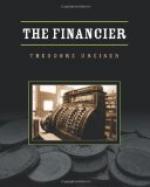A jury to try the case was now quickly impaneled—twelve men out of the usual list called to serve for the month—and was then ready to be challenged by the opposing counsel. The business of impaneling a jury was a rather simple thing so far as this court was concerned. It consisted in the mandarin-like clerk taking the names of all the jurors called to serve in this court for the month—some fifty in all—and putting them, each written on a separate slip of paper, in a whirling drum, spinning it around a few times, and then lifting out the first slip which his hand encountered, thus glorifying chance and settling on who should be juror No. 1. His hand reaching in twelve times drew out the names of the twelve jurymen, who as their names were called, were ordered to take their places in the jury-box.
Cowperwood observed this proceeding with a great deal of interest. What could be more important than the men who were going to try him? The process was too swift for accurate judgment, but he received a faint impression of middle-class men. One man in particular, however, an old man of sixty-five, with iron-gray hair and beard, shaggy eyebrows, sallow complexion, and stooped shoulders, struck him as having that kindness of temperament and breadth of experience which might under certain circumstances be argumentatively swayed in his favor. Another, a small, sharp-nosed, sharp-chinned commercial man of some kind, he immediately disliked.
“I hope I don’t have to have that man on my jury,” he said to Steger, quietly.
“You don’t,” replied Steger. “I’ll challenge him. We have the right to fifteen peremptory challenges on a case like this, and so has the prosecution.”
When the jury-box was finally full, the two lawyers waited for the clerk to bring them the small board upon which slips of paper bearing the names of the twelve jurors were fastened in rows in order of their selection—jurors one, two, and three being in the first row; four, five, and six in the second, and so on. It being the prerogative of the attorney for the prosecution to examine and challenge the jurors first, Shannon arose, and, taking the board, began to question them as to their trades or professions, their knowledge of the case before the court, and their possible prejudice for or against the prisoner.
It was the business of both Steger and Shannon to find men who knew a little something of finance and could understand a peculiar situation of this kind without any of them (looking at it from Steger’s point of view) having any prejudice against a man’s trying to assist himself by reasonable means to weather a financial storm or (looking at it from Shannon’s point of view) having any sympathy with such means, if they bore about them the least suspicion of chicanery, jugglery, or dishonest manipulation of any kind. As both Shannon and Steger in due course observed for themselves in connection with this jury, it was




